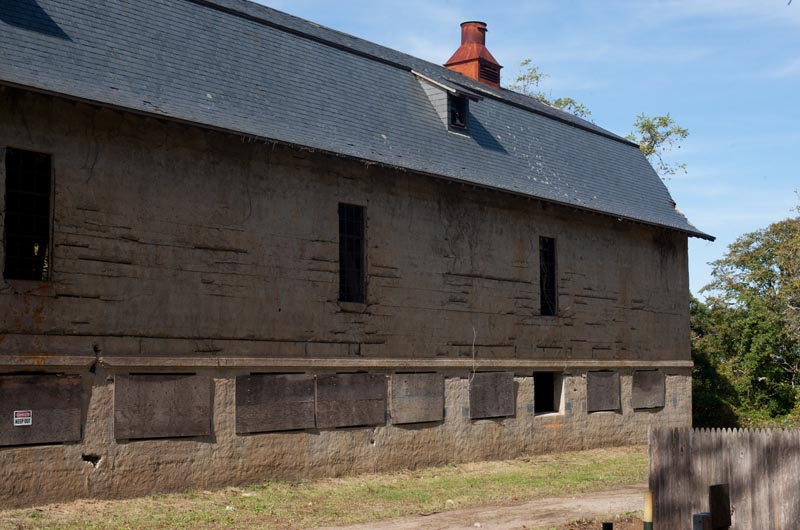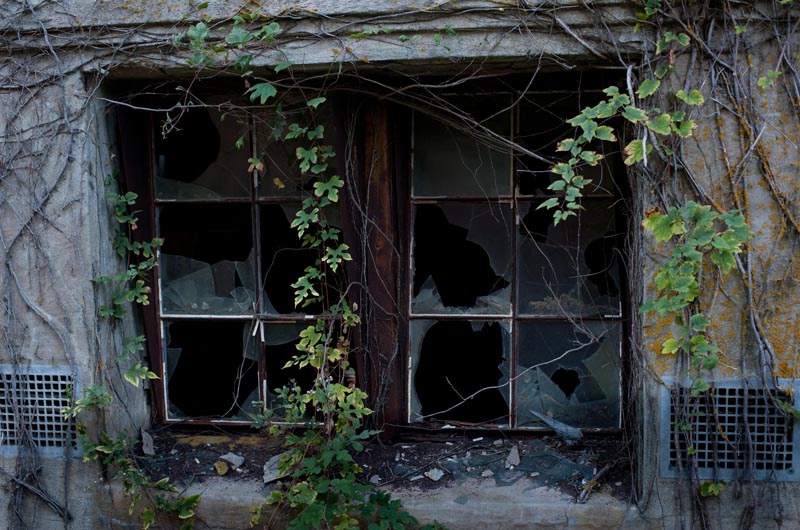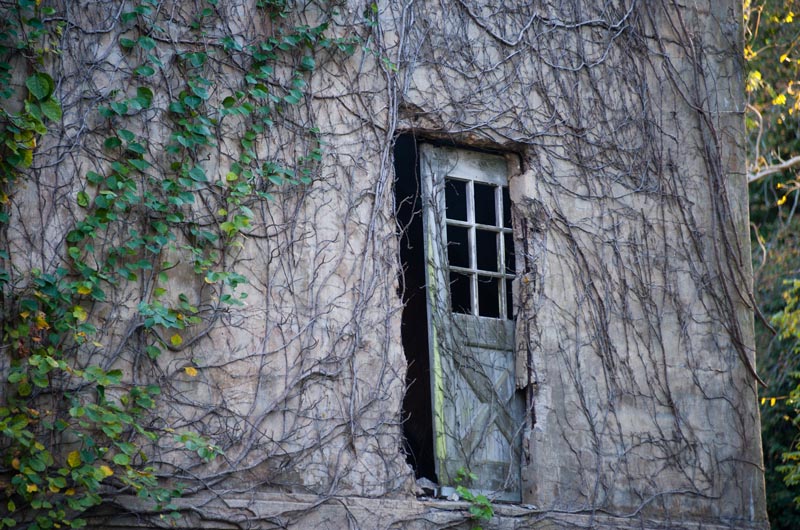The history of Seven Gates Farm goes back to 1887, and for generations a parade of farmers, shareholders and conservationists have done just about all they could to keep the land and buildings of this enclave — spread across the rocky hills of North Tisbury — looking, working and feeling largely unchanged.

Ninety-nine-year-old concrete structure was considered state of art dairy facility specializing in medicinal milk
So for some neighbors it was a difficult business this weekend when they stopped by for a last look at a large old barn before it was demolished because the Seven Gates Farm Corporation could not find the means to keep it standing. When new, the barn was considered to be something close to revolutionary. But from the start it was also structurally flawed, and it did not quite make it to its 100th anniversary, which would have been next year.
“It felt like it was time,” said Everett Bramhall, the most recent co-chairman of a committee that has worked, on and off for at least a decade, to try to save what the Seven Gates community called the big barn.
He was among a small crowd of onlookers who gathered on Monday morning to watch as West Tisbury contractor Dale McClure used an excavator to pull down the towering structure. As the claws of the machine tore off sections, the concrete crumbled easily sending the clouds of dust into the air. The demolition was completed in less than two hours.
“It was so decayed and so frighteningly weak that the ease with which it fell in was quite remarkable,” Mr. Bramhall said. “And that made you realize that — who knows — a big hurricane or a heavy snow [might have brought it down]. The building itself didn’t put up a huge fight. It felt resigned to me.”
Dianne O’Neal, president of the Seven Gates Farm Corporation, said this week the demolition was planned carefully to preserve an even older wooden barn adjacent to the dairy barn. A new storage equipment barn will be built on the demolition site, with construction scheduled to begin by the end of the year, she said.
Two stories high, built of concrete, vastly spacious because it needed no posts and beams, the big barn was built in the period following the publication of The Jungle, the 1906 novel by Upton Sinclair that exposed the horrors of the American meatpacking industry and inspired the government to begin to regulate many types of food production more closely. The barn was built in 1914 to meet the latest standards of a “model dairy farm” on Martha’s Vineyard. Linsey Lee, director of the oral history program at the Martha’s Vineyard Museum and a resident of Seven Gates who lives nearest to where the building stood, produced a short film independently to draw attention to the historic importance of the barn to American agriculture and to the community at Seven Gates. According to the narration given by Rez Williams of West Tisbury: “The technological leap that made possible a sanitary barn was the deployment of a new method of reinforced concrete. In 1903 Detroit-based industrial architect Albert Kahn, today hailed as the architect of the modern industrial era, incorporated the Trust Concrete Steel Company, [which] enabled the construction of large concrete buildings.”
Ms. Lee’s research found that Willoughby Webb, then superintendent of the farm, worked with the architects and engineers at Mr. Kahn’s Boston office to draw the plans for the barn at Seven Gates Farm, using Mr. Kahn’s design of ventilation ports and easily cleaned surfaces to improve hygiene.
Few of Mr. Kahn’s barns are still standing, but several that remain have been registered as national landmarks due to their importance to the agricultural heritage of the United States. To the Vineyard, the significance of the big barn was older and, on the glacial hills of up-Island at least, more closely felt.
The story goes back to the mid-1870s when a renowned professor of geology and essayist from Harvard, Nathaniel Southgate Shaler, began to visit the Island regularly. Though the Vineyard was suffering visibly from the loss of whaling and decline of farming, Professor Shaler was taken with it, and in 1887 he began to buy up neighboring farms in North Tisbury, eventually stitching together some 1,600 acres and establishing Seven Gates Farm — the name came from the number of gates he traveled through to reach his home — as his summer residence.
According to Seven Gates Farm: The First One Hundred Years, by Elizabeth (Tess) Bramhall, Professor Shaler was interested in the Grange movement, an effort to introduce more healthful and financially sound practices to farming. At his death in 1906, Seven Gates went to his daughter Gabriella and her husband Mr. Webb, then a New York attorney. The Webbs moved to the Island and took up the interests and efforts of the professor.
Mr. Webb brought 60 registered Jersey cows to Seven Gates and established the first and largest dairy farm on the Island, following all the latest scientific principles to produce what was then known as “medicinal milk.” He built the barn in 1914; it measured about 140 feet by 40 feet, and with its concrete walls, lofty roof and ease of storage and cleaning, it was a feat of design and construction.
In the film, Clifton Burt recalled how his father Otis, later a superintendent of the dairy, helped to build the barn and delivered Seven Gates milk around the Island:
“He laid all the metal framework for the barn — my father did. And he worked there and then when the barn got filled with cows, they had a regular dairy farm . . . . It was certified milk, and my father drove a big Kelly truck that pedaled milk all around Vineyard Haven and Oak Bluffs. And when I got big enough, I used to go with my father and run to the houses. He’d say, ‘Two quarts to that house and two quarts to that house,’ and I did that when I was about 10, I think.”
But the dairy at Seven Gates was best known for its cheese and especially its butter.

Maintenance stopped in 1960s due to safety concerns.
According to a 1913 account in the New Bedford Sunday Standard Times, quoted in the Seven Gates Farm book, butter from the dairy “supplies one of the country’s most famous clubs, the Chevy Chase Club outside Washington, D.C. The Metropolitan Club in Washington also serves ‘Seven Gates’ butter. . . . A herd of 50 registered Jerseys graze on the hills. The pride of the Farm, on a test for a year, produced three pounds of butter a day. Mr. Webb’s efforts to produce pure milk have been very successful.” The operation won medals from the National Dairy Show in Chicago and New York State Fair, according to the Seven Gates Farm book.
Yet as a flagship dairy, it was short-lived. By 1919, according to the Dukes County Intelligencer, a publication of the Martha’s Vineyard Museum, the steep costs of production and other financial problems had shut down much of the operation, and Seven Gates was back to delivering milk mostly on the Island. The barn itself evolved into a community center for neighbors on the farm and an enormous playhouse for children, especially on rainy days. Movies, Monopoly, badminton, hide and seek, murder in the dark, horsing around in the bales of hay, staging plays and square dances with a caller — for decades these were the games and pastimes that residents took up under the cathedral-like roof of the big barn. (And yet one more activity: “Very good for romances!” said Jane Saltonstall in Ms. Lee’s film.) But all the while, without anyone quite knowing it at first, the barn was deteriorating because of something the builders did right at the start. Lore at Seven Gates says that they used unwashed sand from nearby beaches to mix the cement, and that it was salt in the sand that began almost right away to corrode the rebar that reinforced the concrete. In 1967 Seven Gates prohibited people from going in the barn because even back then it was unsafe.
“The roof itself was totally, beautifully designed,” said Mr. Bramhall of the barn committee. “But the walls holding up the roof were flawed in their material. And it was pretty clear today when we watched some of it coming down, because the rebar that would come out of the walls was just flaky metal.”
Despite the deterioration, shareholders made every effort — going back 10 years at least — to find a way to save the barn, said Ms. O’Neal. Estimates to make the building usable again exceeded $5 million, and to mothball it as an uninhabitable structure touched $2 million, she said. “It wasn’t going to be cheap.”

Doorway to history.
To help with the costs, the corporation went in search of state and federal grants, partnerships, tax credits and other arrangements, but there appeared to be no reasonable way forward: “We fall between the cracks in a very important way, in that we are not a . . . not-for-profit corporation, so that meant that a number of ways we could raise money, and the number of grants we [might] have applied for, we couldn’t qualify for,” Ms. O’Neal said.
Mr. Bramhall agreed: “It was just too much money. We didn’t have it. People would say, ‘Oh, Seven Gates Farm is rich.’ Well, sure, it looks like it. And many people are. But financially the barn was overwhelming for our community. There was a great deal of nostalgia, and it was ultimately overcome by the reality that it was dangerous, it was a liability, it was falling in, we had to deal with it. And so this was where we came to.”
In July shareholders at Seven Gates voted almost unanimously to take down the barn.
Once the demolition machinery went to work on Monday morning, the big barn, built of concrete but shaped something like a basilica, fell in less than two hours. A new barn will soon take its place. But for the present at Seven Gates Farm — and now for the past there as well — a space exists where an irreplaceable but also unrestorable artifact of mainland and Island history had stood for nearly 100 years.






Comments (6)
Comments
Comment policy »